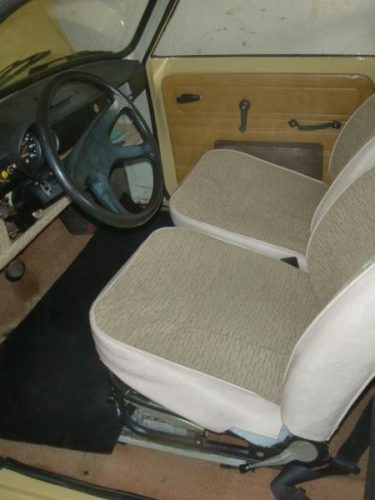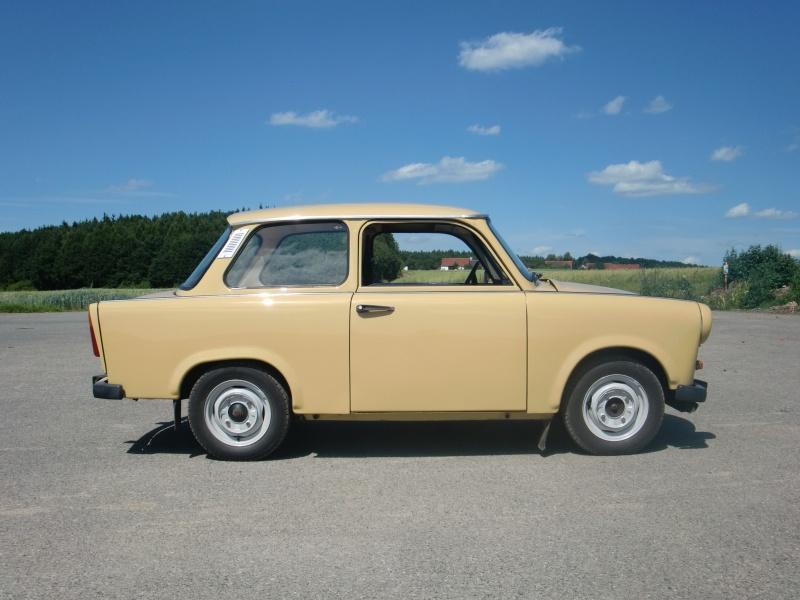Is there any car enthusiast who does not know the term Trabant, as a cult vehicle from the GDR? You can have the pleasure of driving while driving a supersport. You will admire the performance, handling or design. You can have a different driving experience with a Trabant, because after driving you will say to yourself: “How could something so incredibly simple (and actually still can) serve quite reliably?” And that is exactly the philosophy of the creators of the Trabant.
Zwickau – an industrial city in Saxony and the birthplace of the Trabant was originally the base of the Horch car company (founded by August Horch in 1904), which soon became a luxury brand. After disagreements in management, A. Horch went his own way. This is how the Audi car company was born, which is Latin for “to listen”, just as Horch is German. During the economic crisis, there was a grouping of car companies and brought Horch and Audi together. The companies Wanderer and DKW were added to them, and in 1932 the company Auto-Union was established. As part of the Cold War, the GDR was increasingly economically isolated, and sheet steel was in relatively short supply. Therefore, in order to be able to develop the East German “people’s car”, the replacement of body surface parts with other materials with suitable properties had to be solved. The first attempts already took place on the P70 car of the DKW brand, so it was decided that the development of this material would continue and it would be used for series production.

In 1954, a clear request came from the state: to produce a small car with a weight of around 600 kg, the production value of which would not exceed 4,000 marks, and new body material from the P70 type would be used. We are talking about duroplast, which is a material created by pressing several layers of waste cotton and synthetic (phenolic) resin at a temperature of around 200°C. Compared to sheet metal, it does not rust, is quite flexible and does not need to be laboriously welded. Individual body panels were glued, only important places were screwed. The first Trabant P 50 (also 500) began mass production in July 1958, but in limited quantities – only 1,780 cars were produced by the end of the year. From May 1, 1958, the Audi and Horch car companies formed the joint national enterprise VEB Sachsenring Automobilwerke. The chassis parts were supplied by the original Horch plant, the engines were supplied by the Barkas plant based in Chemnitz (originally Karl-Marx Stadt). As the name suggests, the power unit had a volume of 500 cm 3 . It was a two-stroke, air-cooled, two-cylinder engine with an output of 13 kW, lubricated with a mixture of oil and gasoline in a ratio of 1:25. This “power” was transmitted by a four-speed transmission controlled under the steering wheel to the front wheels with a size of 5.20 X 13. The suspension was implemented simply by means of transverse leaf springs on both axles. Brakes were drum on all wheels. With a curb weight of 620 kg, the P50 could go at most 90 km/h. The strengthening of the aggregate came in 1960, an increased compression ratio, modified pistons, a different carburettor and a new exhaust pipe meant an increase in power to 14.5 kW and at the same time a reduction in the lubrication ratio to 1:33. The same year marked the arrival of a station wagon called Universal. It featured a folding rear seatback, making it capable of holding objects up to 1.4 meters long. It thus satisfied the longing voices for a practical version with a large luggage compartment. The year 1962 (model year 1963) was the start for the new type P60 (600). From the previous logic of the connection between the designation and the engine volume, it is clear that the 60-footer received a re-bore engine with a volume of 594 cm3. Thanks to the power of 17 kW, he was already able to start the Trabant at 100 km/h. Four years later, Trabant was presented in the form in which most of us know it best. The Type 601 was presented at the Leipzig Motor Show. The more modern, more angular shapes lasted almost unchanged in production for 27 years. The glazed surface and interior space have also increased. Even before the innovative 601 Universal station wagon arrived in 1967, two years earlier the interesting 601-H with Hycomat electro-hydraulic automatic clutch appeared. The Kübel version with a canvas roof came in 1966. The year 1969 was marked by the final increase in engine power to 19 kW. Fundamental developmental changes in the design did not occur during production, they were mostly modifications, the more fundamental of which are, for example, the exhaust ventilation grilles on the rear pillar (1969), the introduction of needle bearings for the engine piston pins, which made it possible to reduce the oil component in the lubrication ratio to 1 : 50 (1974). The fourth gear was given a freewheel, which made it possible to lubricate the engine better – the long engine braking in the fourth gear on the hills was eliminated, when the closed slide did not allow the engine to be sufficiently lubricated at high speeds. The Tramp model, which was in the service of police soldiers like Kübel, began to be produced in a civilian version (1978). A slight change in appearance, in today’s terms a facelift, came from around 1980. These were new U-shaped bumpers with plastic extensions in the corners of the body. Two years later, the Trabant began to be supplied with self-retracting seat belts and reinforced central pillars of the body. Another two years later, i.e. in 1984, an important change in the electrical installation came as a sign of the transition from 6V to 12V, which enabled, for example, the installation of heated rear glass or halogen lights. It wasn’t until 1988 that the transition from leaf-spring suspension to coil-spring arms was made. After all, a four-stroke engine got under the hood of the Trabi. This happened in 1990, and the Trabant got under the hood a licensed VW engine with a volume of 1,043 cm 3 produced by the Barkas company in Chemnitz. The version was called Trabant 1.1 and was optically distinguished by a more modern mask, front hood and other bumpers. The fuel tank has finally moved to the rear of the car. A completely different front axle with transverse stabilizer and disc brakes already promised adult behavior on the road. The gear lever moved to the ground and the car got wider 155/70 R13 tires. With the four-stroke, the Trabant sped up to 125 km/h and consumed only 5.9 l of finally only “clean” gasoline. The official end of production in 1991 did not mean the end for good, as 1995 saw the arrival of the “Limited Edition” 444, which was a luxuriously equipped version of the 1.1 Universal with an unmanaged catalytic converter.



The most famous, however, is the two-stroke Trabant 601. Its dimensions were characterized by a length of 3,555 mm, a width of 1,504 mm and a height of 1,437 mm. The wheelbase of the “bakeliták” was 2,020 mm. The “six hundred and one” weighed 620 kg, the station wagon was a full 40 kg heavier and also slightly longer (3,560 mm) and taller (1,467 mm). Even though the 600 model was already imported to Czechoslovakia, its successor, the 601, naturally became more popular due to its “long life”. The engine, if it was well maintained, was not as lazy as the paper values might seem. With good adjustment, it can drive around 110 km/h and is definitely quite flexible for a two-stroke. The advantage was good starts and a reasonable consumption of 6-8.5 liters depending on the weight of the driver’s foot. The disadvantage, of course, was the need to mix oil into gasoline, as well as emissions. At that time, every second motorist followed the motto, who lubricates, he drives, so they often added a “drop” of more oil to the gasoline to be sure, which was manifested by a thick blue curtain coming out of the Trabant’s exhaust. Heating for the air-cooled engine was provided by hot air ducting from the exhaust. Unfortunately, an advanced stage of exhaust corrosion was enough, and with the warm air, you also blew exhaust gases into the cabin. For its time, excellent synchronization and gear shifting became plus points for the Trabi, whose control is the pinnacle of functionality. Shifting is provided by a single “bent” rod in a single joint – how simple and yet it works. The rack and pinion steering was also good, light and precise. The driving characteristics could be assessed as sufficient, although harder. Surprisingly, the Trabant became more comfortable when fully loaded. The interior was equipped strictly for purpose, only the most necessary things were in the car. The fuel gauge was also missing, and checking the level of fuel in the tank became a typical “ritual”, when the original dipstick with lines was dipped into the tank. However, the need for a fuel pump was eliminated, because the mixture of gasoline and oil went to the carburetor by gravity.
Trabant cannot be evaluated by today’s standards. It wasn’t built to set racing hearts racing, it was practically a servant to do what was expected of it. Looking at the production numbers, it can be said that this strategy has worked. The total number of units produced reached 3,690,098 units. And what does Trabant actually mean? Latin for guide or kind and it describes it pretty well.




